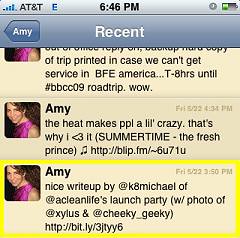Several weeks ago, I posed a question to Mark Drapeau (@cheeky_geeky in Twitter) about tweet attribution and I was glad to see the variety of responses it generated. The question was prompted by something I tweeted and something he tweeted subsequently – which I’ve provided below. In Mark’s defense, I posted the original blog without providing specific details, on purpose. I was interested in his response (and I simply wanted to get the question out there since I was leaving for a 10-day cross-country road trip the next day!) If you notice, in the example I provided, Mark’s tweet is very similar to mine but he clearly changed a few words so it is not verbatim.


I asked the question out of curiosity. My intention was most definitely not an attempt at a light smear campaign. Mark has over 7,000 followers, ranks in the top 30 Twitterers in Washington, DC and is on the program committee for the upcoming Gov2.0Summit – he is clearly one of the top Twitterers for Government 2.0. And I am not passing judgment on what is considered right or wrong for social software behavior. In the case of the example tweet I provided, I don’t particularly care that the essence of my tweet was re-tweeted without attribution because the information was shared with a larger audience (Mark’s 7,000+ followers) – and this is a good thing. But I do care why he did what he did so we can learn – Mark clearly could have just re-tweeted verbatim and still had enough characters to include a RT @sengseng but he took the time to rearrange some of the words and add the location. Perhaps he felt including the venue was more important than providing the source. This doesn’t seem unreasonable. (I am curious about tweets that are re-tweeted verbatim without attribution. Do they all fall under the category of a character constraint or redundancy due to a link to the source’s website?)
When it comes to social media and collaboration, what is the formula, the nuances, and the components for getting a message out to elicit participation, as well as growing a large, vibrant, active community of members? More importantly, what are the personal gains and losses versus the community gains and losses of our actions in these online social forums? At the end of the day, I want the leaders of this brave new 2.0 world to be asking and answering this question. We create a social conscious based on our actions in these virtual environments and in my opinion, we cannot afford to experience the same failings of the finance industry or the real estate market or the automobile industry with Government 2.0.